The Epic of Chitosan; 2007 Jul 15
|
|
|
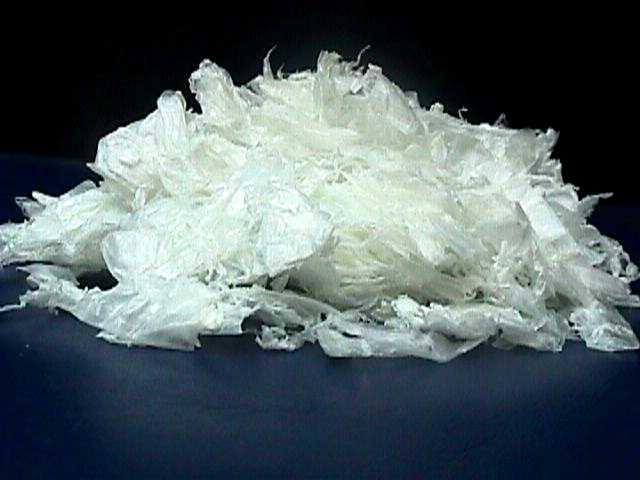 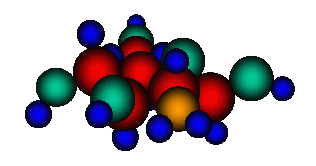 For a span of period from the middle eighties to early two thousands, UKM was quite associated with a 'phantom' called CHITOSAN to some sections of the community; the academia especially. The span was an epic, dwelling a large fraction of the young history of UKM itself - to the date it vanished into the thin air. A number of "people" come-and-go-ed under the shadow of the phantom which suspended motionless like an UFO. Then suddenly, like UFO, it disappeared into the horizon at a lightening speed that even those who had come-and-go-ed woke up to realise that it was a clondyke tale or a mid-summer night dream. Some of them nonetheless managed to distill a considerable pleasure out of the dream, while others hanged on for a secret wish. I missed the "pleasure" because knowing that it was a dream, I could not animate it colourfully enough. For a span of period from the middle eighties to early two thousands, UKM was quite associated with a 'phantom' called CHITOSAN to some sections of the community; the academia especially. The span was an epic, dwelling a large fraction of the young history of UKM itself - to the date it vanished into the thin air. A number of "people" come-and-go-ed under the shadow of the phantom which suspended motionless like an UFO. Then suddenly, like UFO, it disappeared into the horizon at a lightening speed that even those who had come-and-go-ed woke up to realise that it was a clondyke tale or a mid-summer night dream. Some of them nonetheless managed to distill a considerable pleasure out of the dream, while others hanged on for a secret wish. I missed the "pleasure" because knowing that it was a dream, I could not animate it colourfully enough.
|
Chitosan is the major component in most exoskeleton of lower fauna such as crustacean, and mollusc, and insects. Its extraction is rather simple. Beyond that, it requires a lot of imaginations. To this date, this is the only research project that managed to calminate into a JVC commercialisation. Commercialisation of a research project comes with one advantages plus one thousands disadvantages. The fate was similar to that of the "investment" in ICT, or the KBSM phenomenon.
 |
The origin of the project was in late 1983 by Dr Arisol Alimunir who was my hons student in 1979 who then joined UKM and completed his doctorate in Durham in late 1982. The initial move was with another of his batch-mate, who was also my hons student Dr Rusli Ghani. I was approached for advise 1983 September 10 Sat. I had quiet an experience with carbohydrates during my MSc research. Chitosan is basically a carbohydrate, in fact very much simpler, very uniform, compared to the various gums which I dealt with during my MSc. So, I was very glad to join them although during this period I was attempting to use the small Co-60 source for polymer irradiation to continue with what I did for my PhD work. Since this was the only group in 1983 which was visible and rather open for every one, many others jumped into the wagon. Others appeared to work individually. They had wiggled out of the students-days fun of working together. But the rest were covalently bonded by the fun of working together. Chitin-Chitosan Research Group (CCRG) was hatched.
 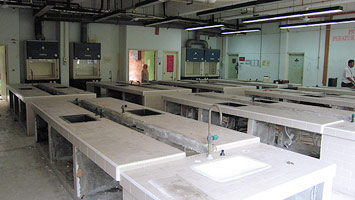  |
| Chitin Lab in 1990. Being renovated in 2006 for teaching. It was taken over from chitin group in 1998. Chitin Group dwelled in the lab since 1983. And the corridor that for many years produce a sporadic smell of "rotting" prawn. |
The group was so glaringly exist by having one whole teaching-size lab on the ground floor (of four floors) of the eastern wing of the lab complex of the Chem Building. It was rather luxury. Plenty of spaces. Many people could flood the area, and a lot of apparatus could get fitted. But the group in its initial fundamental stage did not need sophisticated instruments. It needed only simple apparatus, mostly of vessel type, only that sometimes they were very big. The master plan for the group was very ambitious. The whole excercise was envoloped in a programme. Under the programme were many projects, each researcher being leading a project. I was given the project of "derivatisation", i.e., making new things from chitosan, mostly by chemical modification. I did not need a big space for that, but instead many fine chemicals - and a few fine research assistants. The scope was very extensive. It included investigations in the field of medical anatomy (Prof Dr Abdul Hamid Abd Rashid, and Dr Azian Latif of medical faculty), and immunology (Dr Nasaruddin Abdullah of the Institute of Medical Research).
 |
For the first few years CCRG "walked bare-footed" (berjalan kaki ayam). An application to the ministry of agriculture, was submitted in 1985. The paper clearly pointed to the added value in the agricultural sector; in particular the aquaculture was targeted. The method to value-add the 'wasted' prawn shells was highlighted. It did not poke any body. The means available then were all those accessible only in the lab plus some side orders from the teaching vote. The courtesy of Asia Marine in Pandamaran, Port Klang, warranted a mention here, for they made available for us to collect, all of the raw materials we needed from their cold storage factory, FOC, even at a few hours notice - for many years untill they diversified their business into non-cold-storage.
Cold storage were the targeted source of chitin for they were ready collected. |
In between the job at Matriculation Centre (Chemistry Coordinator) UKM, in which I had to coordinate its chemistry examination matters; a new engagement with Puan Zainah of MPM, on Thursday 1985 Jan 31 for an exactly similar business; running concurrently to the end of the year were chemistry mss preparations (co-authored with Dr Wan Mohamed) for publication with Limma Enterprise in Jln Ipoh, standing published K Moden by Sarjana Enterprise, monthly article of chemistry in Mastika of Utusan, and occasional invitation to write in popular megazine, such as Sarina whose Isnin Tawaf rang me directly on Monday March 25; and in FEP and PFB; March scribling of the proposed ms polymer to be published by DBP, in March, and going to be pervading for many years to come, CCRG moved for a fund application in agricultural sector of the IRPA. It culminated as 01-07-03-002 with a token fund of 10k which the head spent even without the knowledge of all other members, mainly to furnish all those needed for the past two years.
A variant in the epic of chitosan began to bubble up in 1986 from a slow sail by Dr Arisol, Dr Md Pauzi, and Dr Mat Zakaria - by forming a subgroup to lure a commercial interest into the group. The bait was the setup of a factory to produce chitosan locally. It was sweetened by the torrent of news of the material as a wonder material as published in the public media which were digested from the sweet part of the academic journal publications. The edge that could not stop the lips of the moneyists from getting perpetually watered was chitosan ability to absorb body fat, including lipoprotein such as cholesterol. Their vision extended far beyond the horizon. The Group inched forward a step by getting Teroka Rimba to spend finally about 65 kRM to try to set up a chitosan 'plant'.
 The Biro's CEOs who had undergone a chitosanic episode in the epic from 1985: Prof Dr Nik Rashid, Prof Dr Sharifah Mastura, Prof Dr Marzuki, Prof Dr Mohd Fauzi, ... and ghosting to in 2007.., Prof Madya En Zainal Abidin. This was the first project of the kind the BIRO handled. All others were in the form of traditional EIA. |
Inevitably a new entity had to be involved - the "Romans" - then it was known as the Bureau of Consultancy and Extension. The project was sealed and stamped and the so-called first phase was embarked. To the end of the year 1986 half of the first phase survey were carried out, mostly to the cold storages around KL, which we understood that they were not the bulk of them. And that had taken another year 1987 with more survey to be made. The survey to the northern region was made beginning on Wednesday Jan 7 covering Perak, S Prai, Kedah and Perlis. It was like a big hunt; Dr Arisol, Dr Pauzi, and the proprietor En Jalil went along. It took eight days. The bulk of the 'substances' were gathered in this trip. The Parit Buntar and Bagan Serai area was to become a special place later. For the first time Eastern Global Cold Storage in Parit Buntar was engaged. The relevant works went on throughout the year. In early May the survey report was submitted and it was continued with the 'factory' design (phase 2). It was again involved a lot of 'search' for the material needed. And it took through to the end of the year, but fortunately then only back around Klang Valley, the furthest being in Bukit Raja Industrial Area for the chemical-resistant glass-reinforced PE containers which were going to be adapted as the reactors.
Three meetings in 1988 Jan, Jul, and Oct. Naturally the gravity always pull the object downward, never vice versa. The second kick was only in 1990 Jan with the Teroka Rimba proprieter Jalil (an architect) culminated in an attempt to set up a chitosan plant (Ramli Zainuddin were unmatched to the world of academia. T.R. Perusahan was never heard again. All the consumables and detachables were "faraid"-ed.
1988 Mac CCRG submitted another IRPA grant, this time under Industrial Sector, and it appeared that a new light was lit on. Chitosan was heard and visible everywhere. However, I pulled onto the left lane for the time being with the mss running at full speed - the KBSM, the DBP, and the STPM, and the "milestone" I moved from Bandar Baru Bangi to my built residence in Kg Sungai Merab Luar. Then continued into the year 1989 when all beans in my fate bag were spilled. I had with me the only "provision" - nine months sabbatical ending Dec 31. In my "absence" CCRG was awarded 445 k in IRPA 02-07-03-011. It was a huge amount. Other groups were not awarded this much. The operation began in 1990. Several projects were running concurrently; I led the derivatization, with Rohana Masud the RA.
The group made two field trips this year 1990. One was during the school break beginning Feb 23 Fri, south to Kota Tinggi (a break - with kids), LKIM and East Asia Marine Aquaculture, in Sedili; Dept of Agriculture's aquaculture in Gelang Patah, its Kupang Culture in Selat Tebrau in Johore Bharu, and the East Asia Marine's cold storage in Pasir Gudang. The second trip was in late May to the east coast.
1990 Feb, in Sedili LKIM's auction bay, and the "tukun tiruan" project. Not much chitin was visible in Sedili. In Gelang Patah, Department of Fishery Aquaculture, was plenty. But did not sure its "disposal". |
And seeing the non-chitin project in the Tebrau: The Fishery Dept Kupang Culture. |
And in 1990 UKM celebrated its 20 years old. The celebration was officially launched on May 18. Chitosan was the talk of the campus. The Chancellory decided to make a series of press releases as an activity during the celebration. CCRG was picked to start, on Thu May 10. Around the week, the lab was buzzed with people from the media shouldering the cameras and pulling the cable. And in the print media too.
Press conference on May 10 Thu, attended by both the Vice Chancellor Prof Dr Abdul Hamid, and Deputy Vice Chancellor (R&D) Prof Dr Sham Sani, and detail post-recording for broadcasting. Press release on other groups were not as "entertaining". |
 |
 |
The second field trip was to the East Coast in 1990 late May. I joined from a trip to JB, to send off my nephew Mohamad Endut to Makkah while asking him to arrange for a proxy-Haj for my mother (via Ustz Abu Kassim). I also visited Wan Nukman, the son of Che Wan Bakar, my boyhood folk-mate in Terengganu, who was residing in JB and working in Singapore. Transgressed the east coast of Johore, for the first time I saw Endau and Mersing (apart from Sedili in last Feb - all three towns were fishing towns, and was told that many fishermen were from Terengganu, including one of my distant relative in Mersing, Abang Wi had been to and seen her). Rendezvous with the Chitin Grp in Terengganu May 28 Mon, seeing Sutera Semai in Chendering and its farm (the worm and mulberry) in Teresat, Kuala Berang. Then to Kota Bharu seeing the Batik Printing in Pasir Tumbuh, Sungai Bodor (the most polluted river; it was so polluted that its surface was like a mirror fluid solid, and the mother-river looked like the universe upside down - a riversal of blue water under the evening red sun setting sky), and finally the Songket in Penambang. The trip ended up in the sea near Pulau Kapas off Kuala Terengganu coast, on May 31 Thu, "squidding". The adventure climaxed in a torrential storm that left many, especially Dr Rusli Ghani and Dr M Jamil Jais, with inverted excitement. While they were returning to Bangi by Kuantan route, I headed to Kota Bharu to peek at PAP at Simpang Tiga Telipot. I met the PAP founder Haji Hassan, on June 2 Sat, then headed to Bangi via Gua Musang, Kuala Lipis, Raub and Bentong (for first time on this route).
1990 May 28 Mon. In the mulberry farm in Teresat, Terengganu. Seeing the potential mass source of chitin: the spent bombyx morii |
In batik printing training institute, Pasir Tumbuh, Kelantan, for sample of the washings. |
And in the batik printing enclave, the washing of which fed Bodor river which in turn fed Kelantan river. |
 |
As always, Aug was a celebration month. Chitosan was a subject of a 'gallant' exhibition by FSFG students in the festival of 1990 Konvo 18 UKM on Aug 11-14. Chitosan was "provoked" to be able to clean the water. I was given the task to design a device to show the tangible effect. The job deviated substantially from my domain of derivatisation. But it was a heaven lot of fun. For the sake of exhibition, working to late night, every night as the exhibition day nears.
 |
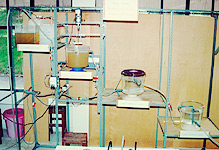  Water treatment model worked well. It began with a make-shift piece-wise assembly, using a small budget that was allocated for me. Plumbing experience during the home building for the past three years was very helpful. The assembly was in the Chitin Lab for demonstration, or perhaps for the visitors. The flow control was very crude. It was the only tangible item for the group. |
From the crude model I designed, a more rigid and portable unit on a rig was contracted and constructed by Norsaidi's PCE; a more sophisticated version, complete with pH regulator. It was known as Water Treatment Chitosan System (WTCS). A chancellory budget was allocated (apparently it was deducted from our IRPA account). The model was ready for show because it could be boarded onto a lorry. There were various exhibitions organised in 1990.
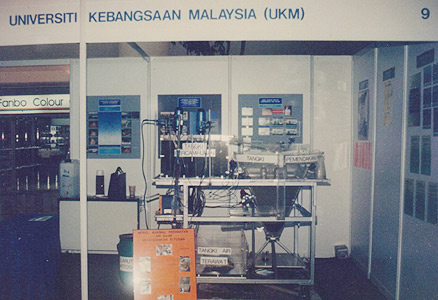 |
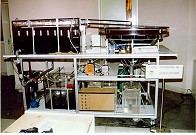 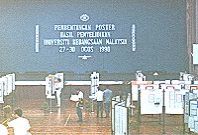 |
The WTCS model was taken to Mindex 90 in PWTC Kuala Lumpur on Aug 20-26; the river water was carried in a lorry and cleaned on the second floor of the exhibition hall (during which I was attending the Course on Water Treatment in UPM - I met Ariffin Saat, SAS-ian 69, who was with Tampin Municipality). A couple of other items from UKM were also displayed. The rig was not that attractive. Perhaps because in the nineties, cleaning water was not the agenda of the time, even with added value of "environmental friendly". The model was then taken home and 'replayed' in the Research Conference Exhibition (part of UKM 20 Yrs activities) in August 27 - 30, in which the palm oil mill effluent was cleaned. The exhibition was officiated by the Education Minister, Datuk Seri Anwar Ibrahim. The model was displayed on the DECTAR Foyer as the prime item. Several other projects (an abstract each) from the CCRG were also displayed on the boards in the main hall. Without this WTCS, the CCRG would fall to level with other groups or individuals.
When the new semester (II) began on Dec 10 Mon for 1990/91 session a doctorate student, Zainal Abidin Harahap (a staff of Universiti Shiah Kuala, Banda Acheh, Sumatra, Indonesia) registered under my supervision. He would carry out a full time research on an attempt to clean palm oil mill effluent (POME) using chitosan system. At least to significantly reduce their turbidity, COD and BOD. With that a new associate was in need, the latest by 1992 early: the palm oil mill. I had in mind already. So that he could spend quite sometimes trying out with the "real time" samples. Dusun Durian Palm Oil Mill in Banting the order of which I acquired from Dr Tusirin from the Golden Hope HQ. His first visit was 1994 Apr 22 Fri.
In 1991, CCRG resumed the survey (part of the IRPA objectives). Jan 9 Wed the 'team' went to the wool processing factory in Semenyih (Malaysian Top Makni). Perhaps the most looked forward was the entourage trip on May 27 Mon up to Langkawi. The trip started along the west coast to United Plantation in Ulu Bernam and put up in Teluk Batik. The following day, the various Cold Storages in Bagan Serai and Parit Buntar (again - the place we had been to in 1987). A break at Kuala Lumpur Hotel in Butterworth (popped in Penang by the ferry in the evening through to almost mid night). May 29 Wed, National Fry Hatchery and Research Centre, Pulau Sayak and a 'resuscitation' in Kangar before crossing the next day May 30 Thu to Langkawi. May 31 Fri, 'rest' on the Pantai Tengah beach. The final day was Jun 1 Sat at Langkawi Aquaculture and a poke at the water treatment plant of the Pelangi Beach Resort.
1991, perhaps the most fruitful stop was at Parit Buntar May 28 when Eastern Global was revisited. And the only one left standing tall since our visit in 1987. |
And Pulau Sayak, May 29. Reserch Centre where fries were hatched, and send to Gelang Patah, Johor for the aquaculture experiment. |
 |
1991 Ogos 21-27. Environmental Day Exhibition. Subang Parade, Subang Jaya: Ministry of Science, Technology and Environment. Exhibition item: Prawn Waste for Treatment of Sewage Effluent. The rig again. This exhibition was scheduled to be held last year 1990 in Langkawi - supposedly after the Mindex 90. It was deferred to this year. Before the exhibition day, the DoE Director General, Dr Abu Bakar Jaafar (SAS-ian 68) himself descended to UKM to inspect the exhibition item.
In 1991, a new front was opened in the effort to promote works towards building more fund by involving the commercial sectors. The term "commercialisation" was not yet a jargon in the university. Even the BIRO was still in the book of "consultancy", but with chitosan on a new different terms the BIRO had no experience before. June 19 Wed an informal meeting in Jln 6 in Bangi was held with a Sumatran delegation (Tg Razman and Tg Musa), in anticipation for a bigger JVC, downlining to effluent treatment. It was followed by a trip to the proprieter's place, 1991 Aug 24 - 28 in Medan, Sumatra (a Trikora). The host was Tg Razman. On arrival, after a lunch at Medan Club we were rested in Tarabunga, Parapat, Toba (ca. 4 hrs drive from Medan in a Toyota's Kijang). Obviously the next day was a tour to Samosir Island in the Toba Lake before being driven back to Medan and put up in Garuda Plaza. Of all the people we met at the hotel, were a full coach of visitors from no other than Sungai Merab, and more, another coachful from Seberang Takir, Terengganu. The actual study tour was on Aug 26 Mon; seeing the prospecting areas around Belawan, and the lab of a sub-Trikora in Medan. It happened that a student in the Grp, Harry Agusnar (an USU staff) was around, and we were guided by him up to USU campus; Aug 27 Tue was another 'academic' discussion on matters related the JVC's contents; a (must) visit to Pasar Ikan Lama - perhaps it used to, but then were flooded with tourism items, especially batik, one each for every body at home. The continuation was carried out informally at the residence of Tg Razman over a dinner, joined by one Malaysian of Indochem, Aris, and Pak Mustafa, a bigger Trikora. The next day the flight home. In principle an MOU was to be signed in a short time. The time of the next visit of the Trikora, then what was named PT Promali Chitin Perdana was hatched.
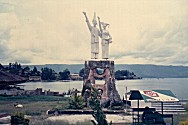    In Parapat, Toba and Samosir background. Lunch in Restoran Garuda in Medan, and in a sea-food production in Belawan. |
1992 was rather 'quiet'. Most activities were reaffirming for the continued cooperations between the interested parties and gathering and disseminating more information. MOU with PT Promali Chitin Perdana was eventually signed, 1992 Sep 29. Unfortunately it stayed signed.
To 'unquiet' the year, CCRG decided to host a regional meeting on chitin and chitosan. A vacum left unfilled since ten years ago. It was decided: Asia Pasific Chitin and Chitosan Symposium (APCCS) And I was made the Hon Secretary.
In the meantime many parties were interested. Chitosan from cold storage was not just the talk of the campus, but apparently also the talk of the country. Sarawak SEDC was also interested knowing that it has within its reach a plenty of aquacultural resources. MTDC was also looking for something to kick. And chitosan project was round enough for it. In fact MTDC's life was in symbiosis with the universities and other reseach institutions. It nonetheless gave us one thing that even the BIRO could not refuse the MTDC's potential participation: the legal aspect of any dealing.
1993 was for the APCCS. The deputy chairman were busy chasing the sponsors he said had pledged quite a sponsorship, that many times I had to chair the meetings, especially towards the end of the year. It was however punctuated by a sad news. The demise of one of the main member of the CCRG: Dr Rusli Ghani on Jun 16 Wed.
1993 Nov 4. Another MOU Signing Ceremony: between UKM (read, CCRG) and Malaysian Technology Development Corporation with Sarawak State Economic Development Corporation (SEDC) and PT Bahari Lestari, Acheh, Sumatra, Indonesia; in Hilton Kuala Lumpur. Two new entries of similar 'genus'. Perhaps the grouping was too big to materialise. This was the third attempt to kick a business venture of a very simple chemistry phenomenon.
Mid term review of IRPA RM-VI was gather in Allson Klana, Seremban, 1993 Dec 19-22. CCRG posted three projects: (1) The Processing Technology of Chitin, Chitosan and Some of Their Derivatives, (2) Chitosan as Chemical Agent in the Treatment of Palm Oil Mill Effluent (POME), and (3) Exploitation of Chitinous Sources in Malaysia and its Vicinity. Obviously by mentioning the events in the list the CCRG had been through, there were all "inertness" after the presentations.
 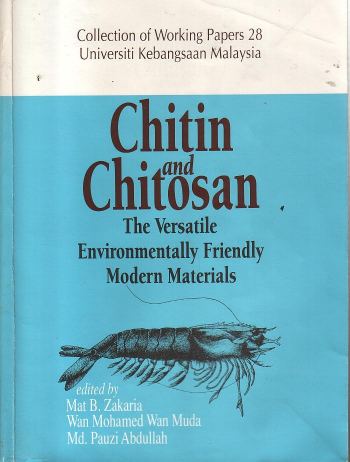 Asia-Pacific Chitin and Chitosan Symposium, May 24 - 27, 1994, Recreation Club House, Universiti Kebangsaan Malaysia, Bangi, MALAYSIA. |
1994 was all set for CCRG to seal its hold in this region by organising the Asia Pacific Chitin and Chitosan Symposium (APCCS), May 24 - 27, in the UKM Recreation Club House. A score of regional and international researchers responded: from Japan, Korea, Taiwan, Hong Kong, Bangladesh, India, Norway, Vietnam, Russia, PR China, Australia, Canada, Britain, Thailand, and the Philipines. Plano speakers were Prof Lee A Hadwiger (Washington State, USA), Dr Gunther Lang (Wella, Germany), Dr Donald D Davies (Nova Chem, Canada), Prof Shigehiro Hirano (Totori, Japan), Prof Seiichi Tokura (Hokkaido, Japan), and Prof Daizo Koga (Yamaguchi, Japan), S. Subasinghe (UN's Infofish in KL), Prof G.A.F. Roberts (Nottingham, UK) and Prof Graham W Gooday (Aberdeen, UK). Prof R.A.A. Muzzarelli (Ancona, Italy) disengaged at last minute, as well as Dr Susumu Kawamura (Montgomery Watson Americas, California, USA). The host pleno was switched at eleventh hour to Dr Pauzi. I was eluded by being the Hons Sec (Bureau's Fadzil was my Exec Sec), but my doctorate student, Zainal Abidin assisted in putting up a poster (as many other locals). The symposium was co-organised with UKM's Bureau of Consultancy and Extension. It was officiated by the Agriculture Minister, Datuk Seri Sanusi Junid, and was closed by the Bureau's Director, Prof Dr Nik Abdul Rashid. The Symposium Dinner on May 26 Thu, in Metro Inn, Kajang, was sponsored by the Ministry of Science, Technology and Environment, Malaysia. The guest of honour, YB Datuk Law Hieng Ding, the minister, was represented by his Ministry Chief Secretary. APCCS was meant to be a setup for Asia Pacific region by which chitin research would be staged on biennial basis. It was agreed that the next meeting (would be APCCS2) would be in Thailand in 1996; the group suggested it to be in the Southern region where a lot of aquaculture could get its spin off. It was a success and I was left with a bundle of papers to be compiled as the proceeding; by near the year end, fortunately by the UKM Press.
The symposium ended rather dramatic. It was not that the new session 1994/95 lecture which began on Jul 4 Mon, but out of whatever reason Dr Arisol tendered a 24-hr resignation on Jun 24 Fri, to join Sea Fresh chitosan adventure in Southern Thailand. And thus at the new session I was made to take over the supervision of Harry from Dr Arisol who took over from the late Dr Rusli last year. Added one new MSc student from India, Rosham, but after half semester he quitted for a better study environment in Singapore. CCRG then fall to Dr Pauzi for the skipping, with some fund of IRPA 02-07-03-011 left to be spent. But the most was to lead the "adventure" many had shown a very keen interest in chitosan shortly after the symposium.
But first, the "baton" of the APCCS: the proceeding. Setting the proceeding was really a full time job: mss re-keyed because none was in the soft copy, diagrams scanned, papers laid-out, and the proof shuttled (by s-mail) to the authors for verification. And I was alone (only with Amipro 3.11 on my 286 AT, HP 4L, and borrowed Deanery's HP scanner) to deliver the CRC (1995 Feb); monitored by the editors, Faezah and later by Antony. The proceeding was finally published the following year 1995 May: Mat B. Zakaria, Wan Mohamed Wan Muda & Md Pauzi Abdullah (Eds.). 1995. Chitin and Chitosan - The Versatile Environmentally Friendly Modern Materials, 372 pp. Bangi: UKM Press (Proc of the Asia-Pacific Chitin and Chitosan Symposium, 1994 May 24-27. Bangi: Biro Rundingan dan Kembangan [Bureau of Consultancy & Extension], UKM). ISBN 967-942-303-4. Infofish International 4/95: 70 (1995); Intisari Ilmu 1995, Bil 4 Okt/Nov; Reviewed by R.A.A. Muzzarelli in European Chitin Society Newsletter, No 5: 3 (1995); the book/proceeding was officially launched by the publisher on 21 Dis 1995. Senada Bil/No 155: 11, 1 Jan 1966. When the proceeding was published, I pushed one step further no other editor ever did. I shoved to the Chemical Abstact. And the proceeding was abstracted. Chem. Abs. 123: 343984e (1995); And the individual paper in the proceeding. Perhaps the first that had been abstracted. And the publisher was deliriously happy.
To this date: APCCS2 in AIT (Bangkok, Thailand) in November 1996; APCCS3 in Taiwan Ocean University, Keelong in September 1998; APCCS4 held jointly with the 8th International Conference on Chitin and Chitosan (ICCC8) in Yamaguchi University, Japan in September 2000; APCCS5 in Bangkok, Thailand 2002 Mar, [jointly organised by National Metal and Material Technology Center (MTEC), Thailand Institute of Scientific and Technological Research (TISTR), Department of Fisheries (DOF), Asian Institute of Technology (AIT), Chulalongkorn University (CU), King Mongkut' s University of Technology Thonburi (KMUTT)]. APCCS6 2004, in National University of Singapore May 23-26. APCCS7 2006, Apr 23-26, Bexco Busan, Korea. The 8th will open a new frontier: APCCS8 in Yangoon, Myanmar 2008 June 3-6.
Post symposium: some articles in the print media - The Sun carried a lengthy stories in Aug. 1, 2, 3, 4. In the 8th Faculty Colloquium 1994 Nov 16, I presented Raw Water Treatment Model Using Chitosan as Chemical Agent. 1994 Nov 21-23, I was invited to present Chitosan - Its Production and Potentials in the National Conference on Production, Handling and Processing of Fish and Fishery Products in Penang Parkroyal organised by MARDI and Penang State Agricultural Committee in collaboration with the Department of Fishery Malaysia and Fishery Development Authority (LKIM) Malaysia.

The third trangression with Eastern Global of Parit Buntar, 1994 Dec 29 Thu, in Taiping Legend Inn, buckled up into a real new chitosan "adventure". The informal meeting with Mr Teoh the MD, et al, with Dr Pauzi, Dr Mat and En Radzi the technician, ticked a kick. The only "bubble" that the EG wanted to assure was the actual cost of production, after quite confortable with the yield. I believed they had made some homeworks in looking into some info on the material. 1995 thus was a dawn. Many people were jovial. But no one took a note that the dawn meant an opportunity for someone to push the dusk to IRPA 02-07-03-011 - ironically in the same breath of the university's yelling for the excellence in research. And to push the dark in the next breath of the "Centre of Excellence". The jargon "commercialisation" began to form a shape, but a stone hammer was ready to strike: the university rules regarding the "profit making" adventure.
Since Dr Arisol left 1994 July, the group admittedly took a pause to regain a new momentum. UKM celebrated its 25th Anniversary, officially launched on January 3, Tuesday in DECTAR. There was an exhibition to accompany the celebration, miniature in size relative to the one held in 1990 (20th Year Anniversary). Chitin Group participated by only putting a poster on Research and Development in Chitin and Chitosan. I wrote a small handout on it Chitin, A Versatile Modern Material, 8 pp. Nonetheless, the first kicking in 1995 was on Tuesday February 5, 1130 hr when I appeared on TV1 telling that chitosan is environmentally friendly for treating domestic water and as effective as alum which was known to caused Alzheimer over a long period of time. It was followed by the Prime Bulletin, TV1, RTM, Mac 5, 2000 hr.
On the background, three main agendas were on the table for 1995. ONE, Eastern Global really was interested in the production of chitosan from their cold storage 'wastage'. MTDC was then well webbed into the "network" and its function was very well defined in the legal part of any dealing. Meetings and paper works spanned almost throughout 1995. Then Nov 26-29, the team from UKM spent at EG premise in Parit Buntar for the so called 'trial' production. All minute data were collected from ca. 500 kg of raw materials. This was the first time the team embarked on this scale. Alas, the expected product was only ca. 15 kg. The product was analysed in detail, including its bioassay, for EG to promote in the pre-marketing. BIRO itself was 'novice' in this new adventure, by intrinsically it prepared for the rodeo. A JVC was mentioned, but the term was still "illigal" in the university and still beyond the periphery of it. MTDC understood very well the meaning of it, and in fact that was MTDC objective in the participation. I was contacted by the Fishery Dept in KL for some info on chitin for their projected development with the promise that, if approved, the portion would be mine to work through. So I submitted Poduction of Chitin and Chitosan 1995 Feb 28. No news since then.
 |
TWO, IRPA RM-VII was in the application stage for the new fund beginning next year 1996. CCRG prepared three proposal. I lead one of them. The other two were lead by Dr Che Rosli and Dr Md Soot respectively. They were submitted to the faculty in late Mar. In the briefing Apr 3 Mon, the dean verdicted that the three proposals should be combined into one. I did that and resubmitted: Production of Fine Chitochemicals from Fisheries Industrial Wastes and Their Utilization in Physicochemical Related Industries with combined researchers: Dr Md Soot Hj Ahmad, Dr Wan Mohamed Wan Muda, Dr Mohd Jamil Jais, Dr Mohd Ambar Yarmo, Dr Md Pauzi Abdullah, Dr Che Rosli Che Mat, Prof Dr Abdul Salam Babji, Prof Dr Abd Hamid Abd Rashid, Dr Muhammad Samudi Yasir, Dr Mohd Khan Ayob, Dr Osman Hassan, Dr Azian Abd Latif. 1995 Jun 8, rumour tricled down that the application was not supported by the dean, the reason being that the project was in the middle of forming a JVC from which the research fund should be extracted. There never was any official letter written on the deliverance of proposal. Apparently the dean modus operandi was on the opposite side of that of the BIRO director who had been selling the research results as the capital which the other parties understood very clearly. No fund, no researh, no results, no capital. In the end, UKM became the poorest share holder. The JVC would be expanding. New capital needed. And UKM capital was the research results valued equivalent to the amount of IRPA fund that CCRG had recieved since 1984, not the money per se. Unfortunately, the dean did not reached the level of needed understanding in the deal.
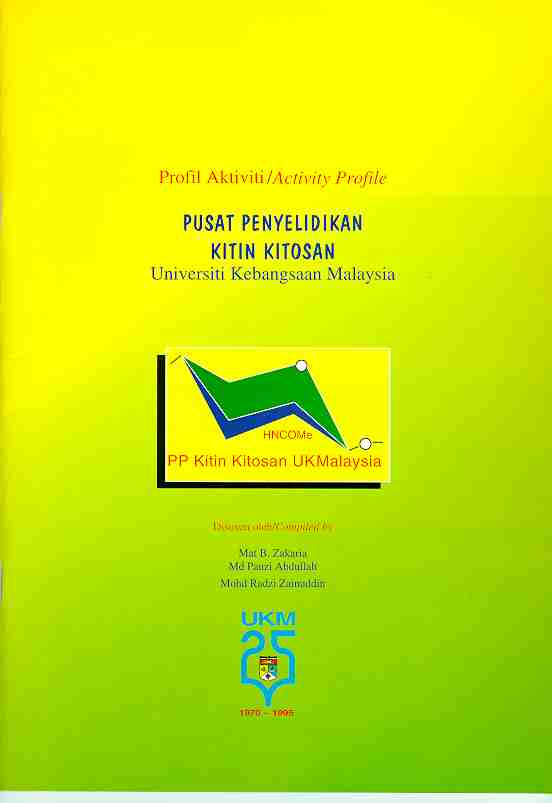 |
THREE, chitosan research which had carved a name, was picked up by the faculty to be shove to the university for the formation of the centre of excellence the university was yelling since last year. No other project was suitable during that time. The paper works were needed to be prepared. It needed a final approval from the senate. A special senate committee was appointed. Apart from the papers, I worked for better document to be presented during the committee hearing. It was the Profil Activiti Pusat Penyelidikan Kitin Kitosan, UKM /Activity Profile of Chitin Chitosan Research Centre, UKM, 92 pp. Bangi: PP Kitin Kitosan UKM. ISBN 983-9152-13-0. Published just before the hearing day, 1995 Sep 21 Thu 9 am. To this day I did not understand why the committee had to amuse themselves with the Centre proposal. In the first place it was the faculty (perhaps the dean himself) that wanted it to be the Centre of Excellence. CCRG, after the symposium, never wanted it. The dean belittled the chitin research saying that almost all were done in the area. And the chairman, a TNC, was very proud in confirming to other members that chitin research had completed and no further area could be explored. It was very "brave" indeed for an academician of that level to spill that kind of words! Another one just looked at the Profile and expressed dissatisfaction about the imperfect english that was used. CCRG was done.
Back to agenda ONE, BIRO still had not come up with a faintest idea about how to circumvate the JVC, to the close of 1995. I thus had all the heaven time with the mss in DBP. 1996 arrived. It was Ramadan from the Jan end. BIRO's director decided to 'confront' NC himself about it. The director took along BIRO's legal adviser and from the CCRG, Dr Pauzi and myself. Jan 26 Fri 9 am. After a brief update, the JVC proposal was spitted out by the director. At this junction it was unbelievable the NC who was yelling research, technology transfer, etc, etc, in the loudest possible dB, the same person, when he was a TNCP, praised to the sky the success of CCRG during the press conference in 1992 May 10 Thu, said, "Does this means that the lecturers would be paid a director salary? Stop it! I do not want a prickly noise about it!"

It was quite another pause in 1996. CCRG was fundless, and every entity seemed against it. But again, I enjoyed myself very much with all kinds of publication workshops while being "borrowed" by the DBP. Every kind: dictionary, encyclopedia, translation, and my own mss. And every where: west to Melaka, north to Langkawi. Then, 1996 Nov 14-15, the Malaysian Technology Development Corporation (MTDC), Ministry of International Trade & Industry (MITI) and Ministry of Science, Technology & Environment (MOSTE) Malaysia organised the First National Technology Connection Seminars in Kuala Lumpur. CCRD was asked to put up with something on chitosan and Dr Pauzi presented: Potential of Chitosan in the Food Industries. After the seminar, a luck striked. One Mr Hiew of Sri Kinsama raised his hand for questions. Then all set for his company to join the band wagon. Dec and to early 1997, Mr Hiew came to UKM many times to understand the chitosan world. And he understood the skeleton that had already been fixed with the EG. His share would be the marketing. 1997 Jan 30 my sabbatical application (2nd time) was rejecting by the dean on the ground that the work I wanted to do during the sabbatical could be accompalished without a sabbatical. My proposal was about the novel determination of degree of deacetylation (DD) of chitosan using XRF which was newly commissioned and still under warranty under the supervision of Dr Ambar. Till then, DD of chitosan was determined using the conventional methods with a poor reproducibality. This was a critical aspect of chitosan which was not resolved satisfactorily. I had in mind that if the method was proven successful, the XRF machine could generate an income from such determinations (rather expensive though) the sample of which would come from all over the world. Unfortunately the dean did not have the level of comprehension.
 |
PP was very confident with the JVC. The owner was looking forward for a local source of chitosan, to replace the imported (from Japan), which he used in his pharmaceutical and personal helth-care products. PP created Nationwide and went all along promoting the products containing chitosan made in ukm-malaysia. I was "borrowed" in all the rallies the Nationwide organised. First 1997 Aug 19 in its Seminar Hall, Taman Maluri, Kuala Lumpur; then Dec 4 in MS Garden Hotel, Kuantan; then Dec 12 in Seri Malaysia Hotel, Johor Baharu; then Dec 18-19 the Rally when I was made the guest of honour; then Dec 26 in Travel Lodge Hotel, Bagan Luar, Butterworth. Nationwide even sponsored Dr Pauzi and En Radzi trip to Lyon, France for 7th International Conference on Chitin and Chitosan, September 3-5.
1997, the corporatisation of the universities took effect. The universities was given the green light to generate its own resorces under what was called the Chancellor Foundation under which BIRO was resited. With that BIRO was licenced to go the way it had in mind. MTDC provided the legal share, independent of the university legal advisors. CCRG was revitalised in 1997. The JVC sprang into life again. Sri Kinsama formed Perfect Persuit (PP) for the JVC purpose, and eagerly requested some commercial sample for a "taste" of chitosan, which the ukm team accomplished in Mac.
Things moved very fast in 1997. An MOU was signed on April 4 in Parit Buntar between the four parties: UKM, MTDC, EG, PP; witnessed by En Anuar the MTDC's CEO. Chitosan filled the media again. 1, 2, 3, 4, 5, 6. 7.

The draft constitution of a JVC was prepared by MTDC legal unit. The final agreement on the formation of a JVC was legally signed on November 28 Fri in UKM BIRO, and the officiation was on December 18 in UKM KRU, witnessed by the Prime Minister's scientific adviser, Tan Sri Professor Dr Omar, and the company, named Chito-Chem (Malaysia) Sendirian Berhad (CCSB) was registered with ROC and incorporated on December 30, 1997; Co number: 456003-T, registered address at the MTDC address.
 |  |
This was the first, and to my retirement date, was the very first, joint venture company UKM successfully set up. And technology was successfully transfered. A long process, since 1990. It passed through three NC and three BIRO's directors. Many people HAD benefited from this project. The chairman of the board of directors was the ex-officio BIRO director, Dr Sharifah was honoured to be the first. Dr Pauzi and I alternately occupied a chair. The secretary (a corporate lawyer) was always from MTDC. EG and PP, each hold two chairs, and individually was majority share holders; combined they always "owned" the company. En Radzi, the CCRG main technician was appointed the plant manager; the university approved his leave of absence for 12 months from Jun 1 1998.
An early visitor from the Philipines, a potential partner. | Mr Saw |
1998, January 27, the first Board Meeting was held in Desa Pandan, the registered office: Chairperson, Dr Sharifah Mastura (UKM); Secretary, En Mohd Nizamuddin Mokhtar (MTDC); Directors, Dr Mat Zakaria (alt by Dr Md Pauzi Abdullah) (UKM), Mr Teoh Han Chew (EG), Mr Teoh Eng Pin (EG), Ms Lim Tin Siew (PP), Mr Blaise Hiew Wiu Ling (PP), Ms Yim Wai Cheng (MTDC). June 1, 1998, was the maiden operation date of Chito-Chem, the beginning date of En Radzi's leave from UKM. It began with the reassembling of the plant.
In 1998 things changed in BIRO as well as in EG, but technically did not effect the operation of Chito-Chem. BIRO director was succeeded by Dr Marzuki. EG management was totally undergoing metamorphosis. The new MD was Mr Saw who fortunately adopted Chito-Chem as his baby, and he assumed the de facto MD of Chito-Chem.
The chitosan plant; daily operation capacity was ca. 30 kg of chitosan, depending on the availability of the raw materials. Close to 1999 end, a stock close to a ton was acquired.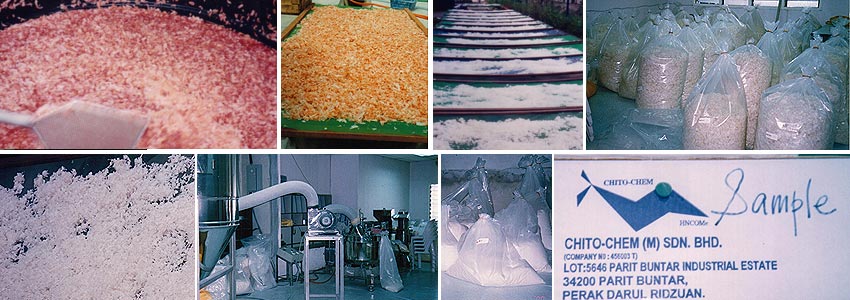 |
1999 May 12 First AGM. BIRO was entirely on new management. New people were riding on Chito-Chem. |
1999 the board met twice, on April 14, and on June 2 (both in Bangi), but the steering committee met almost every month. The production line was renovated and improvised a lot to enhance efficiency. The same was also applied to the post-production. In between the many negotiations arrange with major bulk customers, a grinding machine was purchased. The first AGM was held on May 12 in Parit Buntar with a major decision adopted being the issuance of another one-third million of ordinary shares to current holders. Since UKM share was always the research results, and there had not been a results during IRPA RM-VII because the application was denied, ukm was vulnarable to get its share deswell.
The birth of Chito-Chem was not an event at the department. Not even in BIRO. But it gave me an available vehicle to move around for my hons students projects. I was independent on the department budget. BIRO nonetheless kept Chito-Chem as a token for every body who came to respond to its advert. By then MTDC had a separate cooperation with UKM (in fact with every prime university) to built each an incubator in the campus for the projects adopted. BIRO was the UKM's arm in that dealing. Within that premise, Chito-Chem was given a permanent booth in the Nucleus Block in the UKM incubator. That was where BIRO took the visitors to. 1999 Sep 9, the incubator was officially opened by the then Prime Minister, Tun Dr Mahathir. My last appearence at Chito-Chem Booth of UKM-MTDC Smart Centre was 2000 Jul 6 Thu, to receive the visit of Iran's Education Attache. I had no idea, at my retirement date, whether there was anymore Chito-Chem booth in the Nuclear Block, of the UKM-MTDC centre. The reason d'etre for its site was because it has achieved the goal of commercialisation and technology tranfer.
 |
 |
By the year 1999 end Chito-Chem almost close a deal to purchase an automatic capsuling machine by an invitation visit to the machine factory, on December 20-24, in Taipei and Taoyuan, Taiwan by Kitmah Industrial Supplies, Penang to Chitosan factory and chitosan-related post-production machinery factories. The hosts were: Chin-Yi Machinery Co Ltd, Taishan Hsang, Taipei Shan (Capsule filling machine factory); Shang Yuh Machine Co Ltd, Hsin Chuang, Taipei (Granulating machine factory); Tai Cheer Machniery Enterprise Co Ltd, Ba-Der City, Taoyuan (Grinding machine factory); Shin Dar Bio-Tech Co Ltd, Taoyuan (Chitosan factory); and Kentex Packing Machinery, San Chun City, Taipei (Tube filling machine factory). Mr Hsu of Chin-Yi Machinery was our host in Taipei, and Mr Chen of Tai Cheer Machinery, in Taoyuan. Both hosts were very generous indeed and our stay was very comfortable.
| 1999 Dec 20-24. Mr Saw and I flew to Taiwan in search for some machineries for the downstream chitosan in view that most potential bulk buyers contended the cheaper foreign import. Excuse me for the indifferentiable me in the last two shots. My grandfather's grandfather was a chinese. |
       
|
After being successfully exist, came the toughest task for Chito-Chem. 1999 and 2000 were the closing of the second millenium; 2001 was the beginning of the third millenium. Chito-Chem was the second millenium creature. Thus, FIRST, it has to maintain the existence. It was sufficient to be able to be welcomed all the time when the new manager took over the BIRO. SECOND, to propagate and to progress. This was the hardest part because it involve marketing. And successful marketings were not as those in the textbooks. PP was supposed to do the marketing, but this far, it only negotiate to buy for its own consumption which was very small in term of Chito-Chem output. Mr Saw worked very hard to win bulk buyers. He came down very often to KL from Parit Buntar throughout for the rest of 1999 and 2000, to meet them. I never missed to accompany him and to back him with the technical info.
BIRO's then manager was about to go in 1999. He had been to the Chito-Chem meetings many times and enjoyed very much the sea-food hospitality in Parit Buntar. He did a farewell favour to CCRG by approving a sum to upgrade the Chitin Lab in the basement of Chemistry Building, since we were asked to in 1998, for the original lab was to be used for teaching. I designed the upgrading, introducing the new aluminium slide windows to surmount the problem of blocking the corridors. [Since then many labs on the same level were upgraded, and followed my design.] The new manager, for the second time, was not a scientist. He was an economist. His world view could be expected to be different from the scientists.
Biro sent the contractor 2000 Mar 31 Fri. Ca. six months later the lab was ready to be occupied. |
The Lab had a proper place to keep the "harwares" for future outdoor use. |
MTDC which was created to live in symbiosis with the universities had also enjoyed itself in the Parit Buntar frolic, felt that it had to contribute something to Chito-Chem, from the beginning since 1990. And after the 1997 MOU the EG MD had made a good rapport with MTDC CEO En Anuar. MTDC had in the store what was called CRDF which has a maximum in the figure of 1 M. It was an insentive fund for new university-private venture JVCs to get a kick off. By the first day of operation in Parit Buntar, Chito-Chem had every filled column qualified for the fund. MTDC encouraged Chito-Chem to filled in the form. Mr Saw and I decided exactly just that. The first so-called meeting was 1999 Oct 27 Wed in Kg Pandan MTDC HQ. The officer in charge briefed on what we had already known, i.e., what was CRDF. Mr Saw was of the opinion that, to save our time for the details in the form when comes to the very technical plant items, the job was to be outsourced to the consultant the MTDC itself was happy with. And the consultant was engaged 1999 Dec 9 Thu in BIRO. And the documents were submitted.
The application must be assessed and defended. MTDC appointed Dr Wan Saime of USM as the external assessor. The defence was arranged, 2000 Jun 22 Thu 10 am in R 1104, Menara PSC1, Jalan Sultan Ahmad Shah, Penang (the Office of MTDC Penang) since the assessor was in Penang. En Syed Hisham Alwi and En Rafzan were for the MTDC. Mr Saw and I presented with a paper I scratched. 2000 Nov 7 Tue Mr Saw e-mailed me, that CRDF had been approved, about one-third of what we asked. Fine. The amount was actually covered what we had spent so far to set up the plant. It was a fund, not a loan. The only obligation was that the plant should be set up which Chito-Chem had done that since last two years.
 |
2000 Nov 13 Mon, CRDF fund presentation ceremony in MTDC (latest) HQ in UPM-MTDC Serdang. A total of six entities were awarded. Mr Saw recieved the dummy cheque for Chito-Chem. And Dr Fauzi the BIRO director, being the chairman of Chito-Chem, spoke on behalf, as well as for UKM. And the night that followed, a celebration dinner in Equatorial Bangi. All those involved from the beginning were invited, Dr Fauzi, Dr Md Deraman, Dr Marzuki from BIRO, and those from MTDC itself, all 13 pieces. Apparently this was THE LAST FROLIC OF CHITO-CHEM.
Over the years Chito-Chem was to handle the CRDF fund. It had a dateline, and a time limit. It was a kind of setback to some in the Chito-Chem when the offer document was received. Apparently, tagged with the approval was a directive that about half of the fund should be payble directly to the reserchers for their own future development the way the researchers think most suitable. Obviously the MD did not smile because the balance then did not fully cover the amount that have been spent which mean the account would stay red for another year or two. The chairman did not smile too, probably because of the same reason. It was leaked (one against the other) that two of them agreed not to accept the fund (by not signing the acceptance letter); both of them percieved that accepting the fund with the tagged directive "would make the researchers very rich". MTDC appealed a couple of times, even after the expiry date, to accept the fund, but the managers were very proud of themselves.
My last frolic with Mr Saw was 2001 Apr 9 Mon in Jln Klang Lama, trying to sell chitosan-protein complex to broiler farmer. The point that chitosan reduce the fat was a bad selling point for the broiler breeder, because it reduce the weight of the bird after a cost was added. It was a regresive.
The last meeting I attended was 2001 May 10 Thu in KRU among the board members to prepare documents for the 9th board meeting which never took place. Last dealing about chitosan was 2001 May 14 Mon; Dr Pauzi, En Radzi and I were invited by the CEO of TPM, in Bukit Jalil for a joint research in the layer (chicken for eggs) breeding, which was an integrated farm. Again, like the broiler farmer, our objectives were of the opposite direction. The fat was an internal energy for the layer and should not be extracted out.
2001 was the application year for supposedly IRPA RM-VIII. Irrespective of in or out of CCRG, I advertised a meeting to apply a comprehensive fund. It was Sep 24 Mon in G143 of the PPSKTM. The response from the fellow researcher were very encouraging. Every one was given the task to do. I would lead. After two more meetings, in six months a proposal was ready in the IRPA format: Fine Chemicals from Natural Polysaccharides and Their Applications in Physico-Chemical-Related Industries. And the researchers: Dr Mat B Zakaria (leading), Dr Mohd Ambar Yarmo, Dr Md Soot Hj Ahmad, Dr Mohd Khan Ayob, Dr Osman Hassan, Dr Muhammad Samudi Yasir, Dr Sarani Zakaria, En Wan Yaacob Wan Ahmad, En Rafidi Othman, Dr Md Pauzi Abdullah. 2002 Apr 15 Mon I handed it over to the most experience proposal writer in the group, hoping for him to edit, add, or delete here and there. After about three weeks, it came back with a verbal comment which I did not have a gut to do it. The expiry date passed.
2004 Jan Dr Pauzi and I appllied for a fund from Scientific Advancement Grant Allocation (SAGA) for work in oct 2004 to sep 2006: Fine chemicals and novel derivatives of chitin from Malaysian prawn shells. The negative black and white was recieved.
2006 Jun 8 Thu, Chitosan Mid-day Dream. The Biro's CEO, called a meeting I could not attend. Perhaps its new CEO wanted to have a clear s.q. of the Chito-Chem JVC; as had always been when a new CEO ascended. Lately, BIRO was reduced its answerability. Now, with several others, it answers to Chancellor Foundation. And the current CEO of the foundation is some one who had a connected affair with CCRG in 1994 after the dramatic end of APCCS May 24-27. Words trickled down that the UKM share would be sold for RM1. During the hay-days, the researchers were not shown the proper paper about the agreement with the university. It was "talked about" that out of the 25 hundredth shares that the BIRO handled, it owned only one third. The other two thirds were divided equally among the researchers which was up to the individuals to keep or to sell it to whom ever. The CEO should know that he was talking about only the one third of the 25 hundredth.
2006 Sep, Prof Pauzi, Dr Jumat and I submitted what was supposedly IRPA RM-IX, The Syntheses of Fine Chemicals from Chitosan for Food and Pharmaceautical Applications. Eventually, it was approved as UKM 02-01-02-SF0125; MR201.8K; for works to span 2007 Jul - 2009 June. It was too late. Too bad, I had retired since 2007 Apr 19. And as before, new people will harvest the benefit. Those who had benefited were residing on the top floor, not noticing that I was retiring down below in the basement.
Epilogue: 2007 Apr 19 Thu
 |
 |
